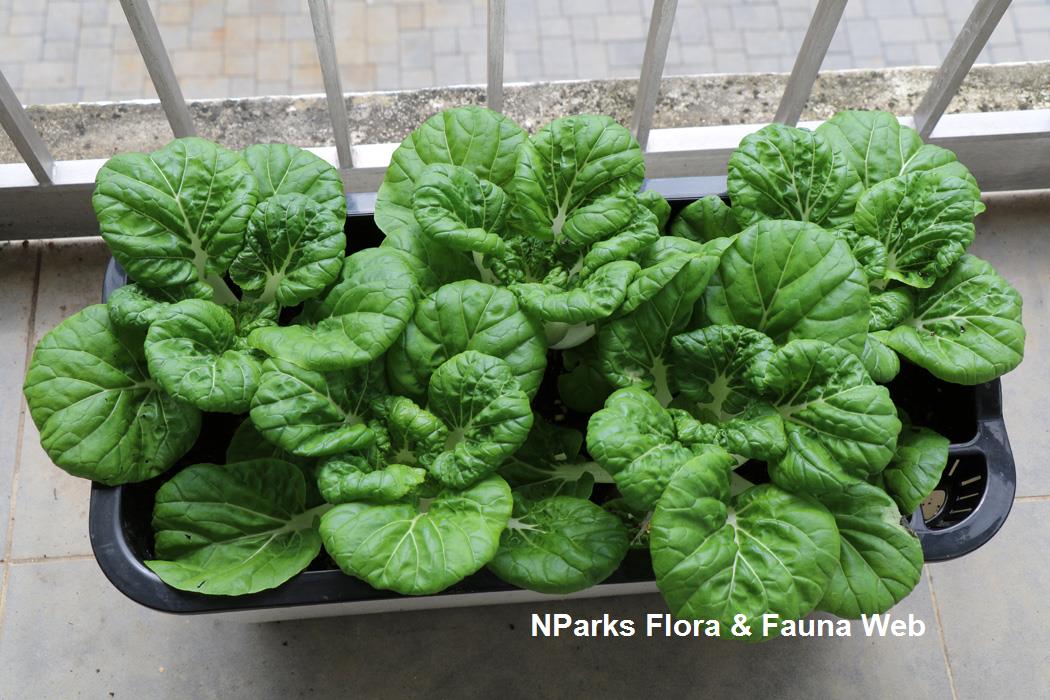
Back
Brassica oleracea Acephala Group [scarlet kale]
| Family Name: | Brassicaceae (Cruciferae) |
| Common Name: | Scarlet Kale, Purple Curly Kale |
Name
Classifications and Characteristics
| Plant Division | Angiosperms (Flowering Seed Plants) (Dicotyledon) |
|---|---|
| Plant Growth Form | Herbaceous Plant |
| Lifespan (in Singapore) | Biennial, Annual |
| Mode of Nutrition | Autotrophic |
| Maximum Height | 0.6 m to 0.9 m |
| Maximum Plant Spread / Crown Width | 0.6 m |
Biogeography
| Native Distribution | Of horticultural origin |
|---|
Description and Ethnobotany
| Growth Form | Biennial herb often grown as an annual. |
|---|---|
| Foliage | The thick, curly leaves are dark purple to red. Young leaves and plants exposed to lower light levels may be bluish-grey with strong purplish red tints. Cool weather causes the leaves to turn a vibrant reddish purple. |
| Flowers | Kale is induced to flower in its second year following prolonged exposure to the cold. The spike-like inflorescence (known as a raceme) is composed of yellow, 4-petalled flowers. |
| Fruit | The dry, dehiscent fruit is a toothpick-shaped pod known as a silique. |
| Taxonomy | Kale is classified as part of the Acephala Group in the species Brassica oleracea. |
| Cultivation | Kale grows best in rich, well-drained soil in a sunny location. You can begin to harvest young leaves from 1 month after sowing seed. Frequent harvesting of the young foliage will encourage the plant to be produce more leaves. Applying a thin layer of compost and forking it in the soil will ensure optimal growth. Planting kale alongside mint in a companion planting will help to repel flea beetles. |
| Ethnobotanical Uses | Edible Plant Parts : Edible Leaves, Edible Flowers Food (Fruit or Vegetable): The leaves are rich in iron and calcium. The tough texture makes it less popular to eat raw, but they can be added to smoothies for extra nutrition. They can be prepared in a variety of methods, like stir-frying with garlic, adding to soups or frying into chips. The edible flowers, known as Kale Raab, are sweet and tender and can be stir-fried in olive oil with salt and pepper. |
Landscaping Features
| Desirable Plant Features | Ornamental Foliage |
|---|---|
| Thematic Landscaping | Economic Garden |
Plant Care and Propagation
| Light Preference | Full Sun |
|---|---|
| Water Preference | Moderate Water |
| Plant Growth Rate | Fast |
| Rootzone Tolerance | Moist Soils, Well-Drained Soils, Fertile Loamy Soils |
Foliar
| Mature Foliage Colour(s) | Blue, Purple, Silver / Grey |
|---|---|
| Mature Foliage Texture(s) | Powdery / Waxy Bloom, Crinkled / Twisted, Thick |
| Prominent Young Flush Colour(s) | Blue, Purple |
| Young Flush Texture(s) | Thick |
| Foliar Type | Simple / Unifoliate |
| Foliar Arrangement Along Stem | Rosulate / Rosette |
| Foliar Attachment to Stem | Petiolate |
| Foliar Shape(s) | Non-Palm Foliage (Ovate, Oblong) |
| Foliar Venation | Pinnate / Net |
| Foliar Margin | Scalloped |
| Foliar Apex - Tip | Rounded |
| Foliar Base | Attenuate |
Floral (Angiosperm)
| Flower & Plant Sexuality | Bisexual Flowers |
| Flower Colour(s) | Yellow / Golden |
|---|---|
| Flower Texture(s) | Smooth |
| Flower Grouping | Cluster / Inflorescence |
| Flower Location | Terminal |
| Flower Symmetry | Radial |
| Individual Flower Shape | Cruciform / Cross-shaped |
| Inflorescence Type | Raceme |
Fruit, Seed and Spore
| Mature Fruit Colour(s) | Brown |
|---|---|
| Mature Fruit Texture(s) | Smooth |
| Fruit Classification | Simple Fruit |
| Fruit Type |
Image Repository
Others
| Master ID | 33663 |
|---|---|
| Species ID | 8077 |
| Flora Disclaimer | The information in this website has been compiled from reliable sources, such as reference works on medicinal plants. It is not a substitute for medical advice or treatment and NParks does not purport to provide any medical advice. Readers should always consult his/her physician before using or consuming a plant for medicinal purposes. |





